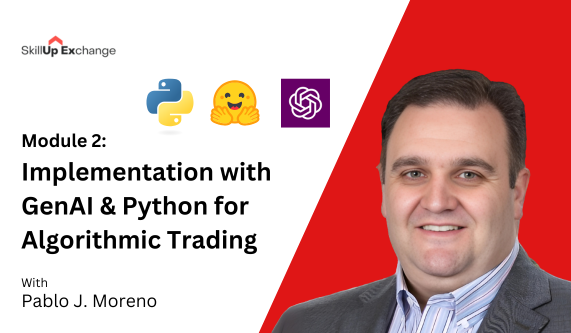Module 2: Implementation with GenAI & Python for Algorithmic Trading with Pablo Moreno
Apply generative AI to build end-to-end trading systems and automate strategy workflows
Transform your Python coding skills into a systematic trading edge. Learn to design quantitative models, integrate LLM-driven signal generation, engineer real-time data pipelines, and deploy risk-managed strategies in production—all powered by GenAI.
4-Week Module
Live Online Sessions
Advanced Level
What You’ll Learn in Module 2
Module 2 focuses on applying GenAI and Python to build, backtest, and deploy end-to-end algorithmic trading systems
✅ Algorithmic Strategy Implementation
Hands-on guidance to configure, backtest, and optimize quantitative trading strategies using Python
✅ Real-Time Data Pipeline Engineering
Build robust ingestion and preprocessing workflows (APIs, web scraping, AI agents) to feed your models
✅ GenAI & LLM Automation
Leverage CustomGPT and fine-tuned LLMs to automate signal generation, synthetic data creation, and strategy logic
✅ Dynamic Risk Management
Implement scenario analysis, stress-testing, and AI-driven hedging frameworks to protect your portfolio
✅ CustomGPT for Trading Workflows
Tailor AI agents to your unique workflow—automate order placement rules, trade alerts, and performance monitoring
✅ Capstone Project & Deployment
Develop, deploy, and present a fully automated GenAI-powered trading system as your module capstone
Meet Your Instructor

“Bridging AI with live markets: code, test, deploy, repeat.“
Pablo has built automated trading systems for hedge funds and taught thousands of professionals how to integrate GenAI into their quant workflows. His sessions blend theory with hands-on coding in Python and R, ensuring you graduate with deployable scripts—not just slides.
Key Expertise
Algorithmic Trading Strategy Design
Quantitative Finance & Portfolio Theory
Machine Learning Engineering (FinGPT, CustomGPT)
Low-Latency Systems & Market Microstructure
MLOps for Trading Applications
Current Roles
Instructor – Quantitative Finance & Algorithmic Trading, SkillUp Exchange
RPA & AI-Agents Guild Lead, Customertimes
Publications & Projects
Machine Learning in Power BI with R and Python
Generative AI and Python for Algorithmic Trading and Quantitative Finance at SkillUp Exchange
Teaching Philosophy:
Pablo believes in learning by doing: you’ll code strategies live, backtest them on historical data, and deploy prototypes to simulated trading environments—all within the module.
Detailed Curriculum
Week 1: Harnessing GenAI for Trading Signals
GenAI Signal Generation
• Use LLMs (Hugging Face Transformers, CustomGPT) to craft and refine trading signals
• Prompt-engineering techniques for financial contexts—structure, parameters, and bias mitigation
Sentiment Analysis
• Apply GenAI to parse and score financial news and social-media feeds
• Integrate sentiment scores into your trading logic
Trend Prediction Strategies
• Develop GenAI-powered models to forecast market movements
• Automate parameter optimization for improved predictive accuracy
Week 2: Automating Your Trading Workflow
Infrastructure Setup
• Architect a scalable trading infrastructure—local vs. cloud deployment
• Secure key management and environment configuration
Order Execution & Management
• Use Python (Alpaca Trade API, os, logging) to programmatically place and manage orders
• Implement dynamic stop-loss, take-profit, and position-sizing routines
Alerts, Logging & Monitoring
• Set up real-time notifications for trade events and system health
• Develop comprehensive logging and performance dashboards
Week 3: Real-Time Data Ingestion & Preparation
API Integration
• Retrieve market and alternative data (stock prices, news feeds) via REST and WebSocket APIs
• Handle JSON, CSV, and streaming data formats
Data Cleaning & Preprocessing
• Implement robust routines for missing data, outlier detection, and normalization
• Use Pandas and Dataprep to structure large datasets for model input
Rate Limiting & Error Handling
• Design resilient ingestion pipelines to respect API limits and recover from failures
• Automate retries, backoffs, and alerting for data pipeline issues
Week 4: Deployment, Automation & Capstone Presentation
Production Deployment & Monitoring
• • Containerize your full trading system using Docker or deploy to cloud functions (AWS Lambda, GCP Cloud Run)
• Set up CI/CD pipelines (GitHub Actions or GitLab CI) for automatic code updates and version control
• Implement real-time health checks and performance dashboards to track live P&L, latency, and error rates
Workflow Automation & Orchestration
• Schedule your end-to-end jobs (data ingestion → backtest → signal generation → execution) with Airflow, Prefect, or cron
• Integrate alerting (Slack, email) for trade events, system failures, and threshold breaches
• Build resilience: retry logic, exponential backoff, and failover strategies to ensure uninterrupted operation
Module 3 Final Project
Capstone – Build Your GenAI-Powered Trading System
End-to-End Integration
Deployment & Live Testing
Performance Evaluation
Ethics & Governance
This comprehensive package will serve as a launchpad for your professional AI creative journey.
Learning Format

Module 2: Using GenAI for Algorithmic Trading is perfect for developers and traders ready to elevate their Python-based strategies with generative AI.
You’ll benefit most if you:
Have basic trading scripts in Python and want to integrate AI-driven signal generation.
Plan to harness sentiment analysis from news and social media to inform your models.
Need to engineer prompts specifically for financial applications and LLM tasks.
Want to automate parameter tuning and optimize strategies using GenAI techniques.
If you’re ready to move beyond traditional backtests and leverage GenAI for smarter, more adaptive trading strategies, Module 2 is your next step.
